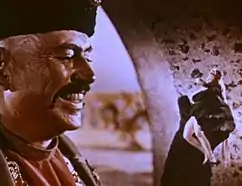Pedro Armendáriz
Pedro Gregorio Armendáriz Hastings (May 9, 1912 – June 18, 1963) was a Mexican film actor who made films in both Mexico and the United States. With Dolores del Río and María Félix, he was one of the best-known Latin American movie stars of the 1940s and 1950s.
Pedro Armendáriz | |
|---|---|
 Frame from trailer for 1963 film Captain Sindbad showing evil El Kerim, played by Armendáriz | |
| Born | Pedro Gregorio Armendáriz Hastings May 9, 1912 Mexico City, Distrito Federal, Mexico |
| Died | June 18, 1963 (age 51) Los Angeles, California, U.S. |
| Cause of death | Suicide by gunshot |
| Burial place | Panteón Jardín, Mexico City |
| Occupation | Actor |
| Years active | 1935–1963 |
| Spouse(s) | Carmelita Bohr (m. 1938) |
| Children | 2, including Pedro Jr. |
Early life
Armendáriz was born in Havana, Cuba, to Pedro Armendáriz García Conde (Mexican) and Adela Hastings (American). He was also the cousin of actress Gloria Marín. Armendáriz and his younger brother Francisco lived with their uncle Henry Hastings Senior in Laredo, Texas, after their mother died. He later studied in California. He started in the world of acting by participating in the stage plays performed by the theater group at the University of California, where he continued a career in law. He graduated with an engineering degree from the California Polytechnic State University.
Career

When Armendáriz finished his studies, he moved to Mexico, where he worked for the railroad, as a tour guide, and as a journalist for the bilingual magazine México Real. He was discovered by film director Miguel Zacarías when Armendáriz recited a soliloquy from Hamlet to an American tourist. His meeting with the director Emilio Fernández was providential, whereupon the actor and director began working in numerous films: Soy puro mexicano (1942), Flor silvestre (1942) and specially María Candelaria (1943) were the first films of intense common path. Under the guidance of Emilio Fernández, Pedro Armendáriz developed the film personality traits of strong nationalist; often, he played tough and manly men, indigenous, peasants and revolutionaries. Amendáriz repeatedly portrayed Pancho Villa and played opposite actresses such as Dolores del Río and María Félix.
With Katy Jurado, Dolores del Río, Amendáriz formed one of the most legendary couples of the Mexican cinema. María Candelaria provided Armendáriz with international visibility. The film was awarded the Palm d'Or at the 1946 Cannes Film Festival. Other prominent titles where Armendáriz appeared with Dolores del Río were Las Abandonadas (1944), Bugambilia (1944) and La Malquerida (1949). Maria Felix was his other partner in such films as Enamorada (1946) or Maclovia (1948).[1]
In the late 40s, he made the jump to Hollywood by the hand of John Ford. Armendáriz was a favorite of Ford, appearing in three of his films: The Fugitive (1947), Fort Apache and 3 Godfathers (both 1948).

Besides his career in the Mexican cinema, Armendáriz made a remarkable career in Hollywood and Europe. His other prominent films in Hollywood were: We Were Strangers (1949, directed by John Huston), The Torch (1950), Border River (1954), The Conqueror (1956) and Diane (1956), among others. In Europe, highlighted his participation in the film Lucrèce Borgia (1953), filmed in France. In Mexico, his participation highlighted such notable films such as El Bruto (1953, directed by Luis Buñuel), La Cucaracha (1959) and La Bandida (1962).
Armendáriz's last appearance was in the second James Bond film, From Russia with Love (1963), as Bond's ally, Kerim Bey. Armendáriz was terminally ill with cancer during the filming of From Russia with Love, and towards the end of shooting he was too ill to perform his part; his final scenes were performed by his double, director Terence Young.[2] Armendáriz died four months before the release of the film.
Personal life
Armendáriz was married to actress Carmelita Bohr (née Pardo) by whom he had one son and daughter. Pedro Armendáriz, Jr. also became an actor and appeared in the James Bond film Licence to Kill (1989); his daughter Carmen Armendáriz became a TV producer.
Illness and death
In 1956, Armendáriz had a role in the film The Conqueror produced by Howard Hughes. The movie was filmed in the state of Utah at the time when the US government was doing above-ground nuclear testing in neighboring Nevada. Within 25 years, 91 of the 220 people involved in the production (41%) developed cancer, 46 of whom died from the disease, or complications related to it.
Armendáriz began to suffer pain in his hips; years later it was discovered that he had neck cancer.[3] He learned his condition was terminal while at UCLA Medical Center in Los Angeles, California, and, reportedly, endured great pain to film From Russia with Love (he visibly limps in most scenes) in order to assure his family financial resources.
On June 18, 1963, Armendáriz committed suicide by shooting himself in the chest with a gun he had smuggled into the hospital.[4] He was 51 years old.[5] He is buried in the Panteón Jardín cemetery in Mexico City, Mexico.[6]
Filmography
Hollywood
|
British cinema
|
Italian cinema
|
French cinema
|
Mexican cinema
|
|
Bibliography
- García, Gustavo (1997). Pedro Armendáriz. Clío. ISBN 968-6932-96-8.
- Tierney, Dolores (2012). "Latino Acting On Screen: Pedro Armendáriz Performs Mexicanness in Three John Ford Films". Revista Canadiense de Estudios Hispanicos, 37 (1). pp. 111–134. ISSN 0384-8167.
References
- Pedro Armendáriz Biography
- BondMovies.com Archived 2010-03-04 at the Wayback Machine
- "Los últimos minutos de Pedro Armendáriz, el hombre que se mató de un disparo en la cama del hospital". Univision (in Spanish). Univision Communications Inc. 21 January 2018. Retrieved 5 March 2019.
- Avendaño, Reyna (18 June 2018). "Pedro Armendáriz y la trágica historia detrás de su suicidio". El Universal (in Spanish). Retrieved 5 March 2019.
- Holston, Kim R. (11 July 2015). Susan Hayward: Her Films and Life. McFarland Publishing. p. 217. ISBN 9780786480883.
- EFE (22 June 2013). "A 50 años de la muerte de Pedro Armendariz". El Tiempo Latino (in Spanish). Retrieved 5 March 2019.
External links
- Pedro Armendáriz at IMDb
- Pedro Armendáriz at AllMovie
- Pedro Armendáriz at the TCM Movie Database

- Pedro Armendáriz (in Spanish) at the Cinema of Mexico site of the ITESM
- Pedro Armendáriz at Find a Grave